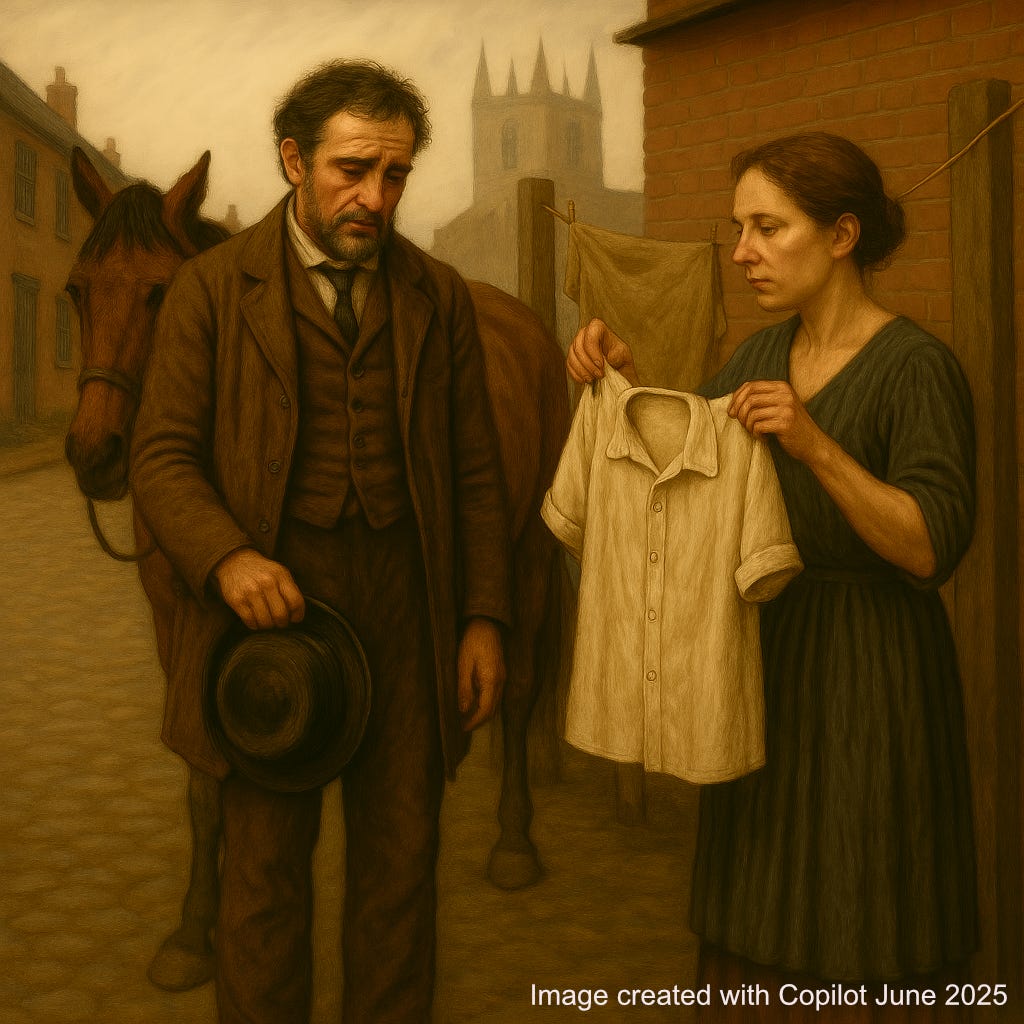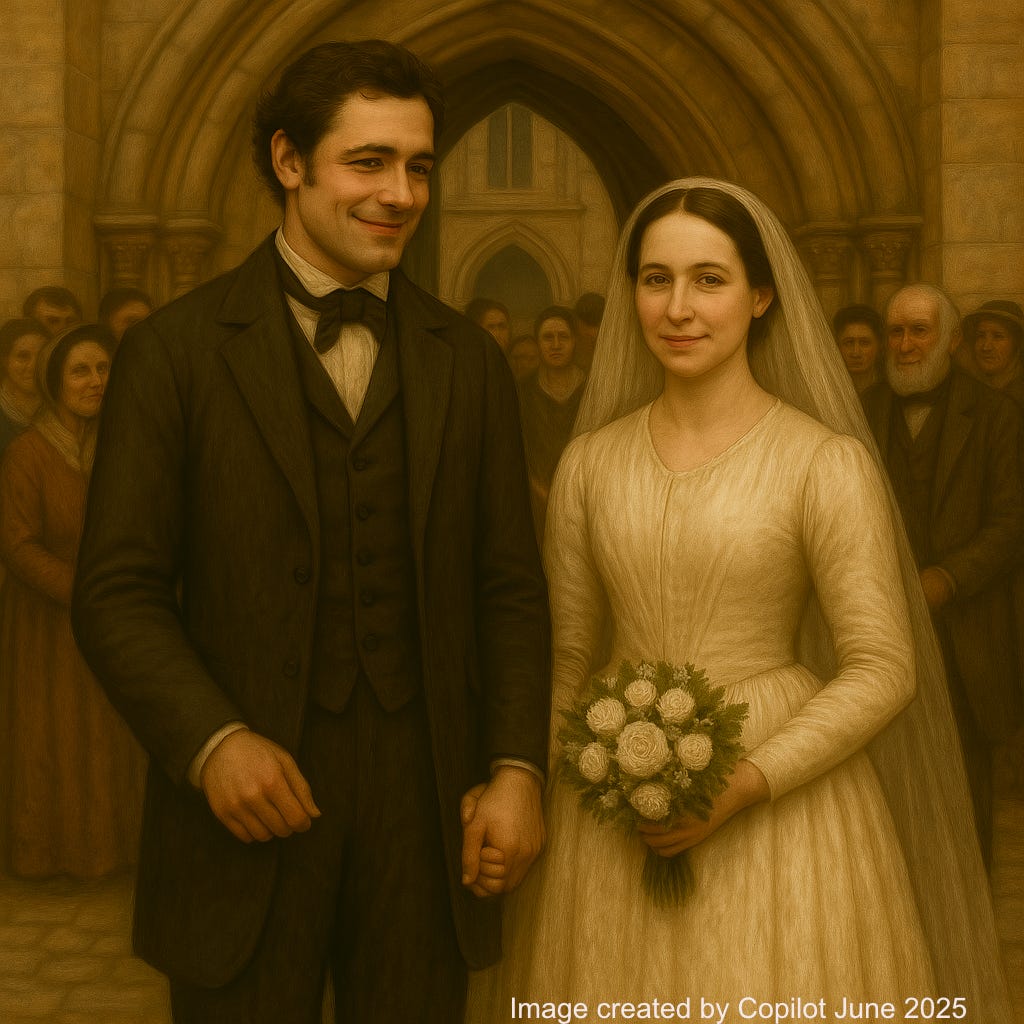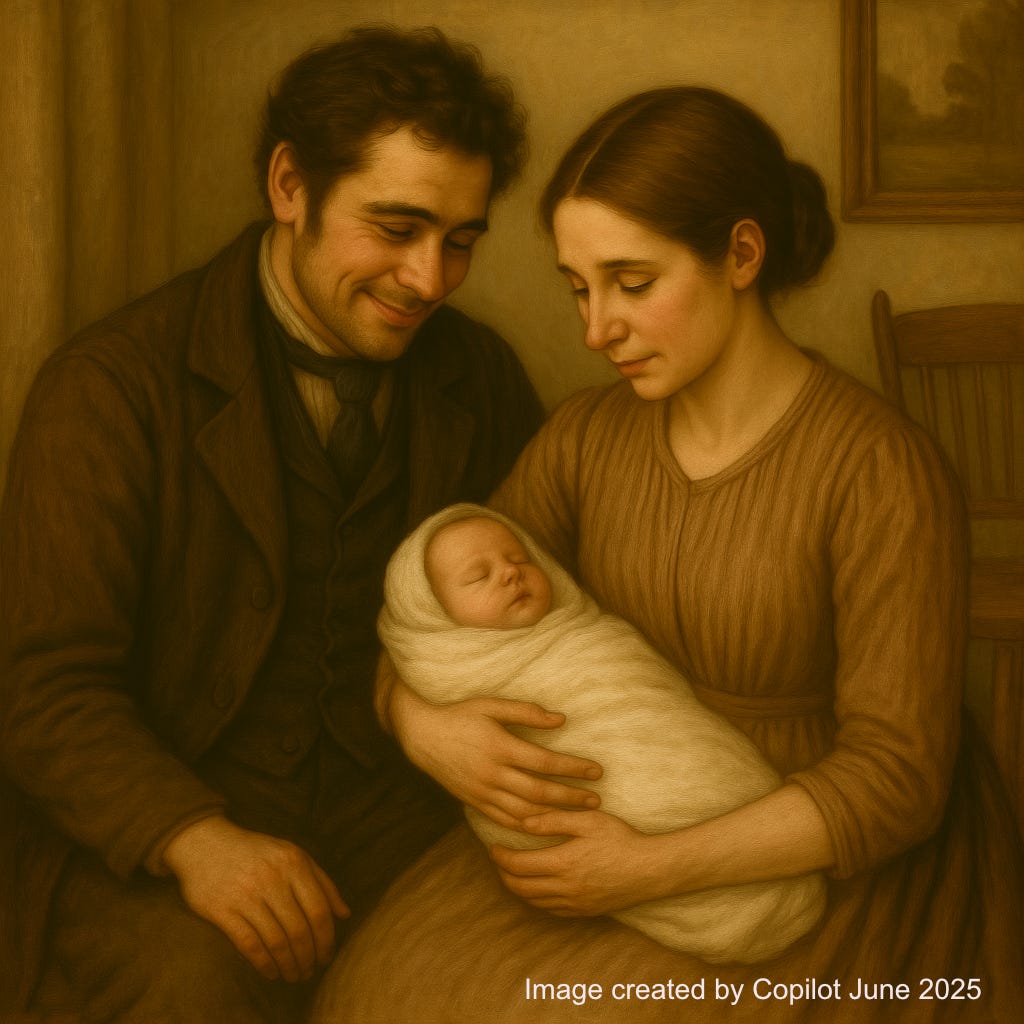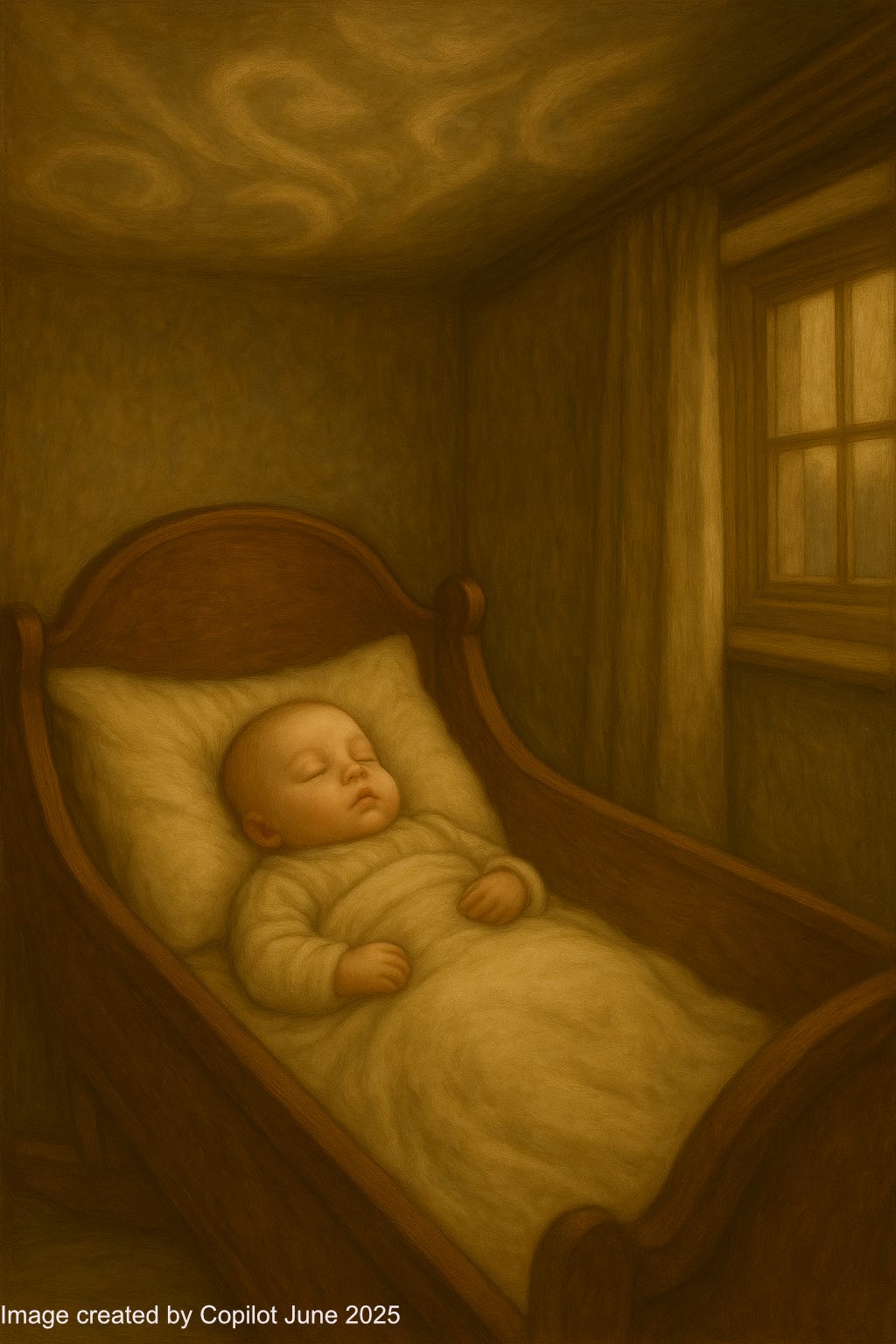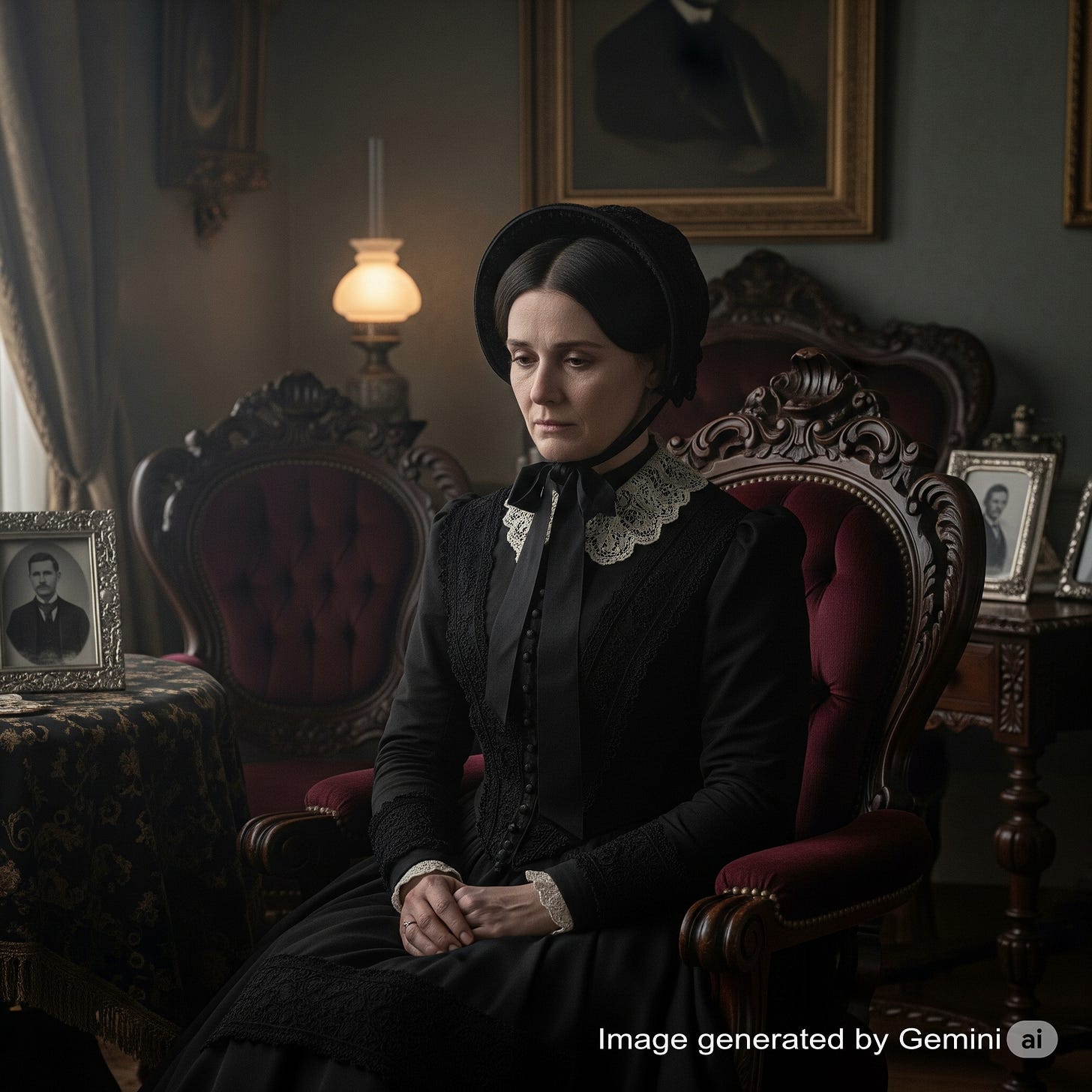The London Express and the Life It Claimed
As told by Anne Carson (née Hollingworth)
Author's Note
This story is a work of creative fiction based on historical facts about my great-great-grandmother, Anne Carson (née Hollingworth). Following on from my first post "The Day Everything Changed," which told the story from twelve-year-old Constance Annie's perspective, I wanted to explore the same tragic event through Anne's eyes as the wife and mother at the centre of this family crisis.
I’ve used real census records, newspaper accounts, and family history, however, the emotional narrative and daily life details are imagined to bring Anne's experience to life. I wrote this story with the assistance of AI tools—specifically Claude.ai and ChatGPT. The images have been created using a combination of Google Gemini and Microsoft CoPilot.
The AI assistance allowed me to explore what Anne's inner world might have felt like during this tragic period, while ensuring the narrative remained true to the known facts and the social context of 1870s England. This approach to collaborative storytelling with AI has given me a way to honour my ancestors' experiences and bring their stories to life in a more vivid, emotionally resonant way than traditional genealogical research alone could provide.
The News That Changed Everything
I was hanging washing on the line behind our house on Green Lane when I heard the horse's hooves—urgent, desperate, nothing like the measured clip-clop of Mr. Brentnall's delivery cart or young Tom Fletcher's pony. The sound made my hands still on John's best shirt, the one I'd been so particular about getting the paint stains out of the cuffs. Such foolish concerns we carry— until the world turns upside down and we realise they never mattered at all.
It was Henry's voice that reached me first, calling my name with a tremor I'd never heard before. John's younger brother had always been the steadier of the two Carson men—while my husband was all passionate enthusiasm about his work, Henry was measured, careful with his words. But that Saturday afternoon in September 1873, his voice cracked like a boy's.
I dropped the shirt back into the basket and walked toward the front of the house, my wet hands smoothing my apron out of habit. Through the kitchen window, I could see Henry dismounting, his face grey as October sky. And I knew. Before he spoke a word, before he took off his hat and turned it round and round in his hands, I knew that the life I'd built with John Carson was over.
"Anne," he said, and his voice broke entirely. "There's been an accident."
The rest came in fragments—the Midland Railway, Hendon station, the London express that never stopped, Friday afternoon, over a hundred miles away. But I'd stopped listening after "accident" because my body already understood what my mind refused to accept. I felt myself sink onto the front step, my legs suddenly unable to hold the weight of what was coming.
Henry had travelled all that way, spent the morning identifying what was left of his brother at that terrible place so far from home, then made the long journey back to tell me. Two days of knowing, carrying this burden alone, before he could reach me with the news.
John. My John, with his paint-stained fingers and his dreams of grand commissions. The man who'd lifted me from my father's farm into a world I'd never imagined—gone since Friday, and I'd spent the weekend going about my ordinary tasks, never knowing I was already a widow.
When Love Began with Paint Under His Fingernails
But let me tell you about the beginning, when everything was possibility and promise.
I was Anne Hollingworth then, twenty-eight years old and the seventh child of a West Hallam farming family. By rights, I should have been settled long before, but I'd been particular about suitors. My mother despaired of me, I think—here I was, practically an old maid by the standards of our neighbours, still living at home and helping with the dairy work.
John Carson came to Hallam House to paint the ballroom—and everything changed.
I first saw him in the village on a Tuesday market day in early spring of 1857. He was talking to Mr. Holbrook about timber for scaffolding, his hands moving as he spoke, sketching shapes in the air. Paint clung under his fingernails—deep blue and gold—and I wondered what grand vision called for colours like that.
He was thirty-two then, older than the farm boys who'd fumbled through proposals over the years. There was something solid about him, purposeful. When he caught me staring from across the market square, he didn't look away like most men would. He smiled instead, and I felt something flutter in my chest that had nothing to do with the spring wind.
We were properly introduced by Mrs. Newdigate herself, who thought it amusing that her painter had taken such obvious notice of "that sensible Hollingworth girl." John was working on the ballroom at the time, preparing for some grand celebration, and he asked if I'd like to see what he was creating.
I shouldn't have said yes—it wasn't proper for an unmarried woman to go walking with a tradesman she barely knew. But there was something about the way he spoke of his work, the pride in his voice when he described the designs he had planned, that made me forget propriety entirely.
The ballroom took my breath away. John had transformed the space into something magical—intricate patterns on the ceiling, elegant flourishes along the walls, every detail executed with such care and skill. But it was when he showed me his preliminary sketches that I truly fell in love. Not just with him, but with the world he inhabited—a world where beauty was created by skilled hands and artistic vision.
"Painting isn't just about covering walls," he told me as we stood in that magnificent room. "It's about creating something that lifts people's spirits, makes them feel they're part of something grander than their everyday lives."
We were married four months later, on August 8th, 1857, at St. Peter's in Derby. I wore my mother's cream silk—the one she'd been married in—and John wore a new suit he'd commissioned specially for the occasion. His hands were clean for once, scrubbed free of paint, but I rather missed those telltale stains that marked him as a man who created beautiful things.
Building a Life Together
The early years of our marriage were a revelation. John's business was growing—word of his work at Hallam House had spread, and he was getting commissions from increasingly prominent families. We moved from his bachelor lodgings to a proper house in West Hallam, and for the first time in my life, I suddenly had servants to help with the work I'd done all my life.
It was a strange adjustment for a farmer's daughter. I'd been raised to work from dawn to dusk—milking cows, churning butter, helping with the harvest. Suddenly I found myself with time to read, to do fine needlework, to call on other wives in the village. John encouraged it all, proud to see me becoming what he called "a proper gentleman's wife."
"You deserve beautiful things, Anne," he'd tell me when I protested about some new dress or piece of furniture. "You've worked hard enough for one lifetime."
Our first daughter, Mary, was born in March 1858, less than a year after our wedding. John was beside himself with joy, pacing the house like a caged animal while the midwife attended to me. When he finally held his daughter, his hands—those capable hands that could create such beauty—shook with wonder.
"She's perfect," he whispered, tears streaming down his face. "Look at those tiny fingers, Anne. She'll be an artist like her father, mark my words."
Mary was followed by Anne in 1861, born just as John's business reached new heights. By then, he was employing four men and had earned a reputation as one of the finest painters and decorators in all of Derbyshire. We had moved to a larger house, hired Hannah Clark as our housemaid, and I found myself part of the comfortable middle class I'd never dreamed of joining.
Anne was a different baby than Mary—quieter, more observant. She would lie in her cradle for hours, just watching the patterns of light and shadow on the ceiling. John was convinced she had an artistic temperament.
"She sees things, that one," he'd say, bouncing her on his knee. "Look how she studies everything so carefully."
Our youngest, Florence, arrived in 1863, completing our family. She was the liveliest of the three, always reaching for things just beyond her grasp, always wanting to be in the middle of whatever was happening. John adored her fearless spirit.
The Height of Our Happiness
By 1871, when we moved to Green Lane in Ockbrook, I thought I had mapped out the rest of our lives. John's work with the Midland Railway Company was steady and well-paid. All three girls were in school—even little Florence was learning her letters. We attended All Saints Church every Sunday, hosted dinner parties for John's fellow tradesmen, and I had begun to think of myself as permanently settled in this comfortable life we'd built together.
I remember one evening in particular, just a few weeks before that terrible Friday. John had come home from working on the London Extension, full of enthusiasm about the project. The Midland Railway's new line to St. Pancras was nearly complete, and he'd been contracted to inspect and maintain the paintwork at several of the intermediate stations.
"It's the future, Anne," he said over dinner, his eyes bright with excitement. "Railways connecting every corner of England, bringing prosperity and progress to places that have never seen such things. And I'm part of it—my work is helping to build something that will last for generations."
Mary, fifteen and trying so hard to be grown-up, asked practical questions about his work. Constance, twelve and still dreamy, wanted to know if the trains were beautiful. Florence, ten and irrepressible, demanded to know when she could ride on one of the grand express trains to London.
John answered all their questions with the patient enthusiasm that made him such a wonderful father. But it was his comment to me later, as we prepared for bed, that I remember most clearly.
"I've been thinking, Anne," he said, hanging up his work clothes with the same care he brought to everything. "Perhaps it's time to expand the business further. Take on larger projects, maybe even work beyond Derbyshire. The girls are getting older—they'll need dowries, opportunities. I want to make sure they have choices we never had."
I remember feeling a flutter of anxiety at the suggestion. We were comfortable, secure. Why risk what we'd built for the uncertain promise of something larger? But I didn't voice my concerns. John's ambition had brought us everything we had. I trusted his judgment completely.
If only I had known that his ambition—the very thing that lifted us—would be the thing that took him.
The morning of September 26th began like any other—quiet, routine, safe. John left early, as he often did when working on the railway stations. He kissed me goodbye, ruffled Florence's hair as she ate her porridge, and reminded Mary to help me with the washing.
"I'll be back before dark," he promised, the same promise he'd made hundreds of times before. "We'll have dinner together, and I'll tell you all about the progress at Hendon."
I watched him walk down Green Lane, his tool bag slung over his shoulder, whistling some tune I couldn't quite identify. The morning sun caught the silver in his hair—when had he gotten so much grey? We'd been married sixteen years, but in my mind, he was still the confident young painter who'd shown me the transformed ballroom at Hallam House.
The day had proceeded normally—washing, mending, supervising the girls' lessons. Mrs. Anthony from next door stopped by to borrow some sugar. Young Mrs. Henry asked after John's work. Hannah Clark came to help with the heavy cleaning, as she did every Friday. It was all so wonderfully, blessedly ordinary.
Until Henry's horse came thundering up Green Lane, and ordinary ended forever.
The inquest was held three days later at the Midland Hotel in Hendon. I had to travel there—me, who had rarely been more than ten miles from home—to hear the details of how my husband had died. Henry came with me, bless him, though I could see the strain in his face every time someone mentioned John's name.
The porter, Hopkins, gave his testimony with the careful precision of a man who'd rehearsed his words many times. He'd seen John walking along the permanent way, checking the station buildings as he often did. The London express had been running on schedule, approaching Hendon at full speed with no intention of stopping. John, focused on his work, apparently hadn't heard it coming.
"It would have been instantaneous," the coroner assured me, as if that knowledge could somehow make the horror more bearable. "He wouldn't have suffered."
But I would suffer. Oh, how I would suffer.
The jury's verdict was "Accidentally killed," with no blame attached to anyone. As if John's death was simply one of those things that happened, like bad weather or crop failure. As if the life we'd built together could be dismissed as casually as spilled tea.
After the Storm
The funeral was the last time I felt like Mrs. John Carson, respectable tradesman's wife. After that, I became something different—Anne Carson, widow, seamstress, woman struggling to keep her daughters fed and housed.
The transformation happened with shocking speed. John's tools and remaining paint had to be sold to pay outstanding bills. The house on Green Lane was too expensive to maintain without his income. The Midland Railway Company provided a small pension—their guilt money, I suppose—but it wasn't enough to live on.
Within six months, we'd moved to smaller lodgings, and I'd taken up my needle professionally for the first time since my youth. My hands, soft from years of gentle living, grew rough again from constant work. My back ached from bending over mending and alterations late into the night.
But the hardest part wasn't the physical discomfort or even the financial worry. It was watching my daughters learn that the world was far less secure than they'd believed. Mary, my eldest, tried to help by finding work as a housemaid, but the strain broke something in her spirit. She had what the doctors called "nervous exhaustion" and had to be treated at the asylum for several months.
Anne, my steady middle daughter, found work as a pattern girl with a family in Nottingham. She sent money home when she could, but I hated that a child should have to support her mother. Florence, my baby, learned to mend and sew alongside me, her childhood shortened by necessity.
The community helped as they could. Mrs. Henry continued to stop by with small kindnesses—a pot of soup, help with heavy work, company during the long evenings. The rector's wife organised donations of fabric and notions for my sewing work. Hannah Clark, dear soul, continued to help even though I could barely afford to pay her.
Kindness wrapped in charity is a bitter thing to swallow, once you've known independence.
The Final Chapter
The cancer came for me nine years after John's death, as if my body had simply decided it was tired of carrying grief. By then, Mary had recovered her health and found steady work. Florence was becoming quite accomplished with her needle. And Constance Annie, my steady middle daughter, had returned home to care for me during my final months. She had been working as a pattern girl with a family in Nottingham, but when sickness came, she gave up her position to nurse me through the worst of it.
It was Annie who sat by my bedside during those long nights, who helped me with the correspondence when my hands grew too weak to hold a pen, who made sure I was comfortable and never alone. She had met James by then — a good man who understood that family came first, who waited patiently while she tended to her dying mother.
As I lay in bed during those final months, I often thought about that morning when everything changed. How different our story might have been if John had chosen a different profession, if the railway expansion had happened a few years later, if he'd simply looked up at the wrong moment.
But then I would remember the ballroom at Hallam House, the pride in John's voice when he spoke of his work, the comfortable life his skill had provided for us. The railway might have killed him, but it had also given us sixteen years of happiness, three beautiful daughters, and a love story that began with paint under his fingernails and ended with him creating beauty until the very last day of his life.
I regret many things—words unspoken, moments I wish I'd treasured more fully, the anxiety I let cloud our final weeks together. But I don't regret loving John Carson, or the life we built together, however briefly we were allowed to keep it.
After my death, Constance married her James Ryan Caddy and sailed to Western Australia with their newborn son. She carried with her not just my blessing, but the strength we'd found together during those difficult final months—the knowledge that love persists even through loss, that families endure even when scattered across oceans.
The morning John died, I was hanging his shirt on the line, fretting about paint stains that would never wash clean. Now I see those stains for what they were—the mark of a man who brought beauty into the world, even in the humblest of places.
I kept that shirt until the day I died, paint stains and all. It was the last thing of his that still smelled like turpentine and hope.




